Addressing Ethical Issues: An Anti-Bribery Policy and Analysis Report
VerifiedAdded on 2022/08/24
|6
|1661
|23
Report
AI Summary
This report delves into the critical ethical issue of bribery and corruption within business organizations, recommending a comprehensive anti-bribery policy as a preventative measure. It evaluates the ethical decision-making models applicable to the policy, emphasizing the importance of compliance with anti-bribery laws like the Foreign Corrupt Practices Act. The report highlights the social responsibility aspects of the policy, stressing the need for open and honest communication with stakeholders. It analyzes the policy's framework, objectives, and zero-tolerance approach, while also acknowledging its limitations, such as the need for continuous review and the potential for bribery outside of the organization. The report underscores the importance of training, whistleblowing procedures, and consistent communication to ensure the policy's effectiveness in maintaining ethical business practices and protecting the organization's reputation.
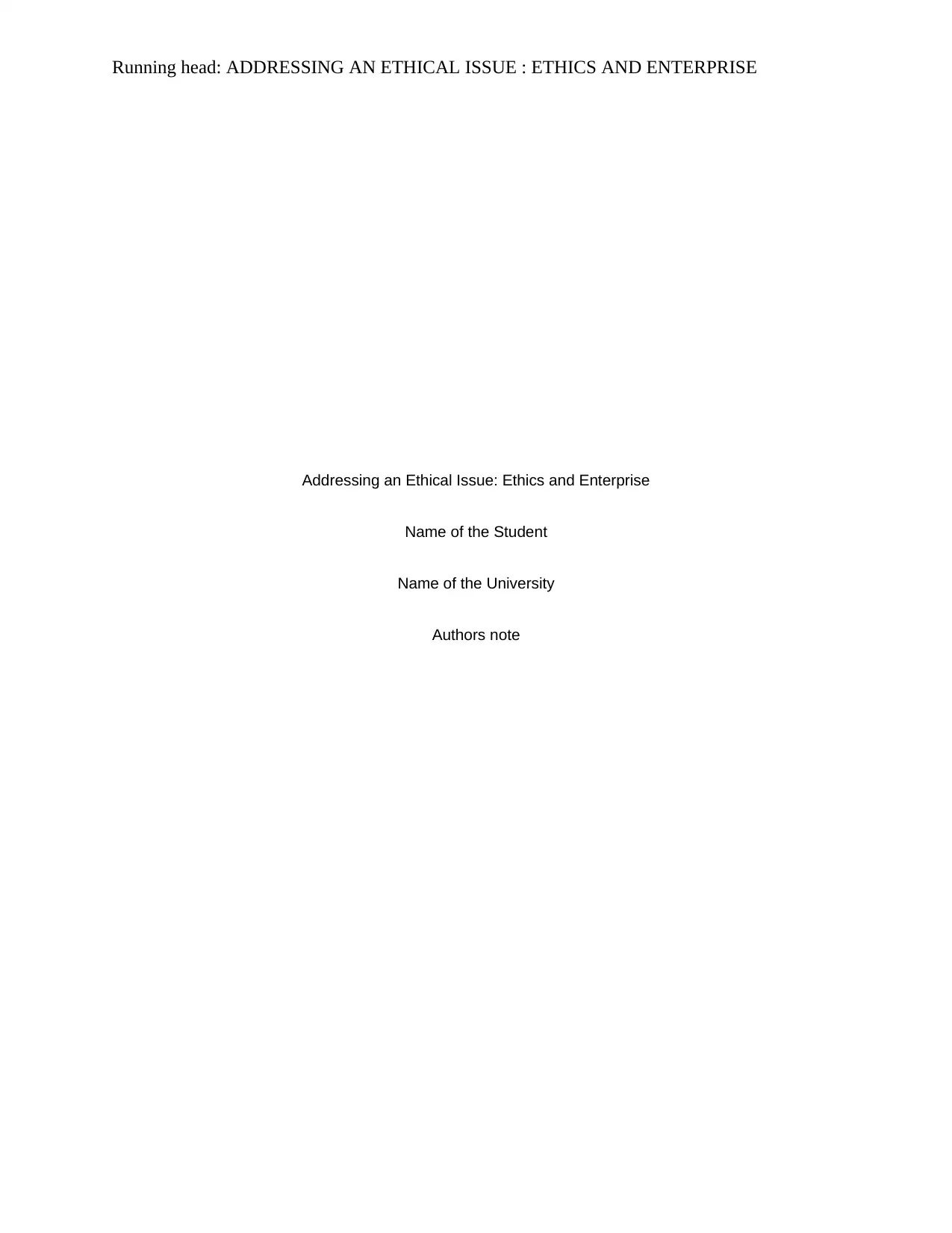
Running head: ADDRESSING AN ETHICAL ISSUE : ETHICS AND ENTERPRISE
Addressing an Ethical Issue: Ethics and Enterprise
Name of the Student
Name of the University
Authors note
Addressing an Ethical Issue: Ethics and Enterprise
Name of the Student
Name of the University
Authors note
Paraphrase This Document
Need a fresh take? Get an instant paraphrase of this document with our AI Paraphraser
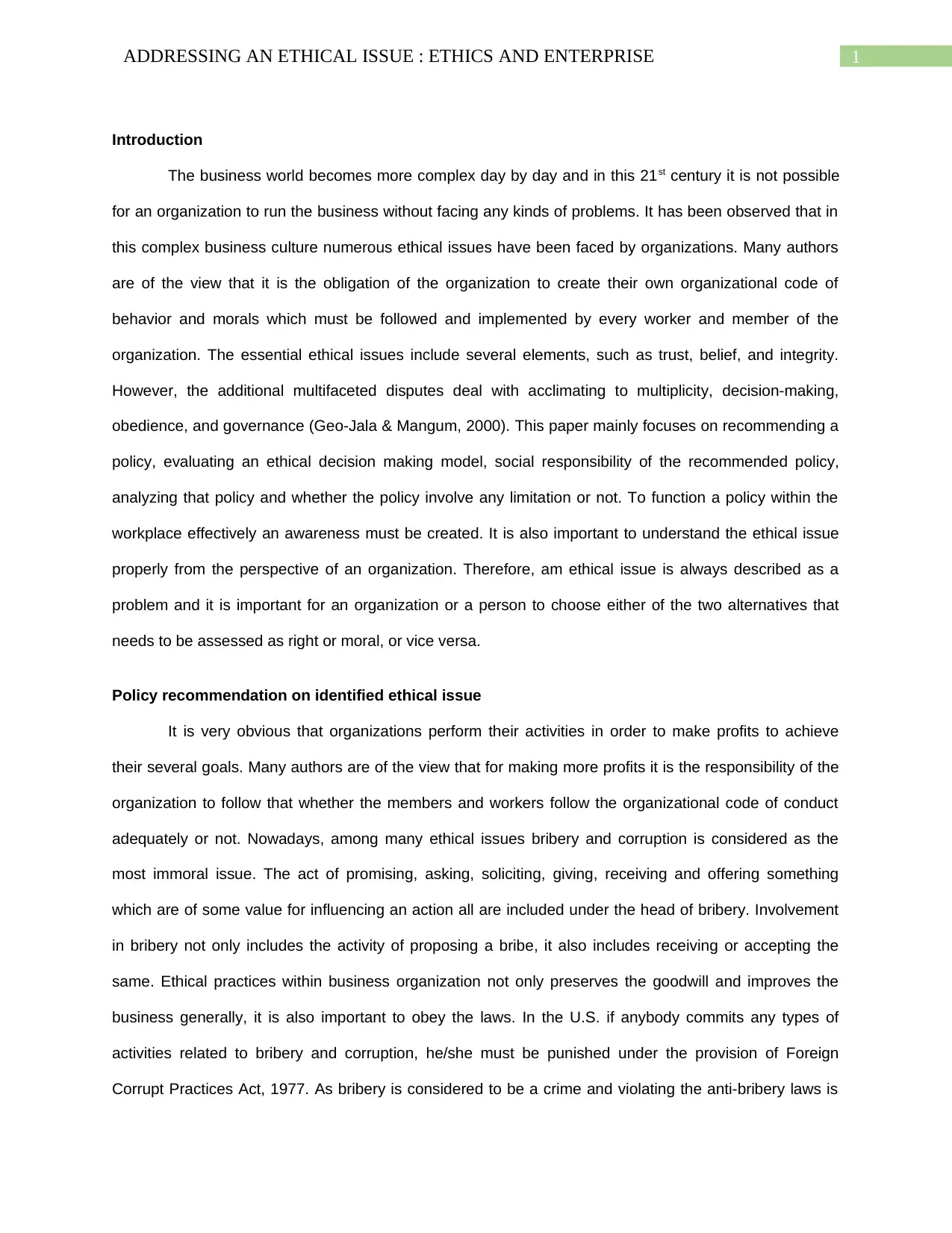
1ADDRESSING AN ETHICAL ISSUE : ETHICS AND ENTERPRISE
Introduction
The business world becomes more complex day by day and in this 21st century it is not possible
for an organization to run the business without facing any kinds of problems. It has been observed that in
this complex business culture numerous ethical issues have been faced by organizations. Many authors
are of the view that it is the obligation of the organization to create their own organizational code of
behavior and morals which must be followed and implemented by every worker and member of the
organization. The essential ethical issues include several elements, such as trust, belief, and integrity.
However, the additional multifaceted disputes deal with acclimating to multiplicity, decision-making,
obedience, and governance (Geo-Jala & Mangum, 2000). This paper mainly focuses on recommending a
policy, evaluating an ethical decision making model, social responsibility of the recommended policy,
analyzing that policy and whether the policy involve any limitation or not. To function a policy within the
workplace effectively an awareness must be created. It is also important to understand the ethical issue
properly from the perspective of an organization. Therefore, am ethical issue is always described as a
problem and it is important for an organization or a person to choose either of the two alternatives that
needs to be assessed as right or moral, or vice versa.
Policy recommendation on identified ethical issue
It is very obvious that organizations perform their activities in order to make profits to achieve
their several goals. Many authors are of the view that for making more profits it is the responsibility of the
organization to follow that whether the members and workers follow the organizational code of conduct
adequately or not. Nowadays, among many ethical issues bribery and corruption is considered as the
most immoral issue. The act of promising, asking, soliciting, giving, receiving and offering something
which are of some value for influencing an action all are included under the head of bribery. Involvement
in bribery not only includes the activity of proposing a bribe, it also includes receiving or accepting the
same. Ethical practices within business organization not only preserves the goodwill and improves the
business generally, it is also important to obey the laws. In the U.S. if anybody commits any types of
activities related to bribery and corruption, he/she must be punished under the provision of Foreign
Corrupt Practices Act, 1977. As bribery is considered to be a crime and violating the anti-bribery laws is
Introduction
The business world becomes more complex day by day and in this 21st century it is not possible
for an organization to run the business without facing any kinds of problems. It has been observed that in
this complex business culture numerous ethical issues have been faced by organizations. Many authors
are of the view that it is the obligation of the organization to create their own organizational code of
behavior and morals which must be followed and implemented by every worker and member of the
organization. The essential ethical issues include several elements, such as trust, belief, and integrity.
However, the additional multifaceted disputes deal with acclimating to multiplicity, decision-making,
obedience, and governance (Geo-Jala & Mangum, 2000). This paper mainly focuses on recommending a
policy, evaluating an ethical decision making model, social responsibility of the recommended policy,
analyzing that policy and whether the policy involve any limitation or not. To function a policy within the
workplace effectively an awareness must be created. It is also important to understand the ethical issue
properly from the perspective of an organization. Therefore, am ethical issue is always described as a
problem and it is important for an organization or a person to choose either of the two alternatives that
needs to be assessed as right or moral, or vice versa.
Policy recommendation on identified ethical issue
It is very obvious that organizations perform their activities in order to make profits to achieve
their several goals. Many authors are of the view that for making more profits it is the responsibility of the
organization to follow that whether the members and workers follow the organizational code of conduct
adequately or not. Nowadays, among many ethical issues bribery and corruption is considered as the
most immoral issue. The act of promising, asking, soliciting, giving, receiving and offering something
which are of some value for influencing an action all are included under the head of bribery. Involvement
in bribery not only includes the activity of proposing a bribe, it also includes receiving or accepting the
same. Ethical practices within business organization not only preserves the goodwill and improves the
business generally, it is also important to obey the laws. In the U.S. if anybody commits any types of
activities related to bribery and corruption, he/she must be punished under the provision of Foreign
Corrupt Practices Act, 1977. As bribery is considered to be a crime and violating the anti-bribery laws is
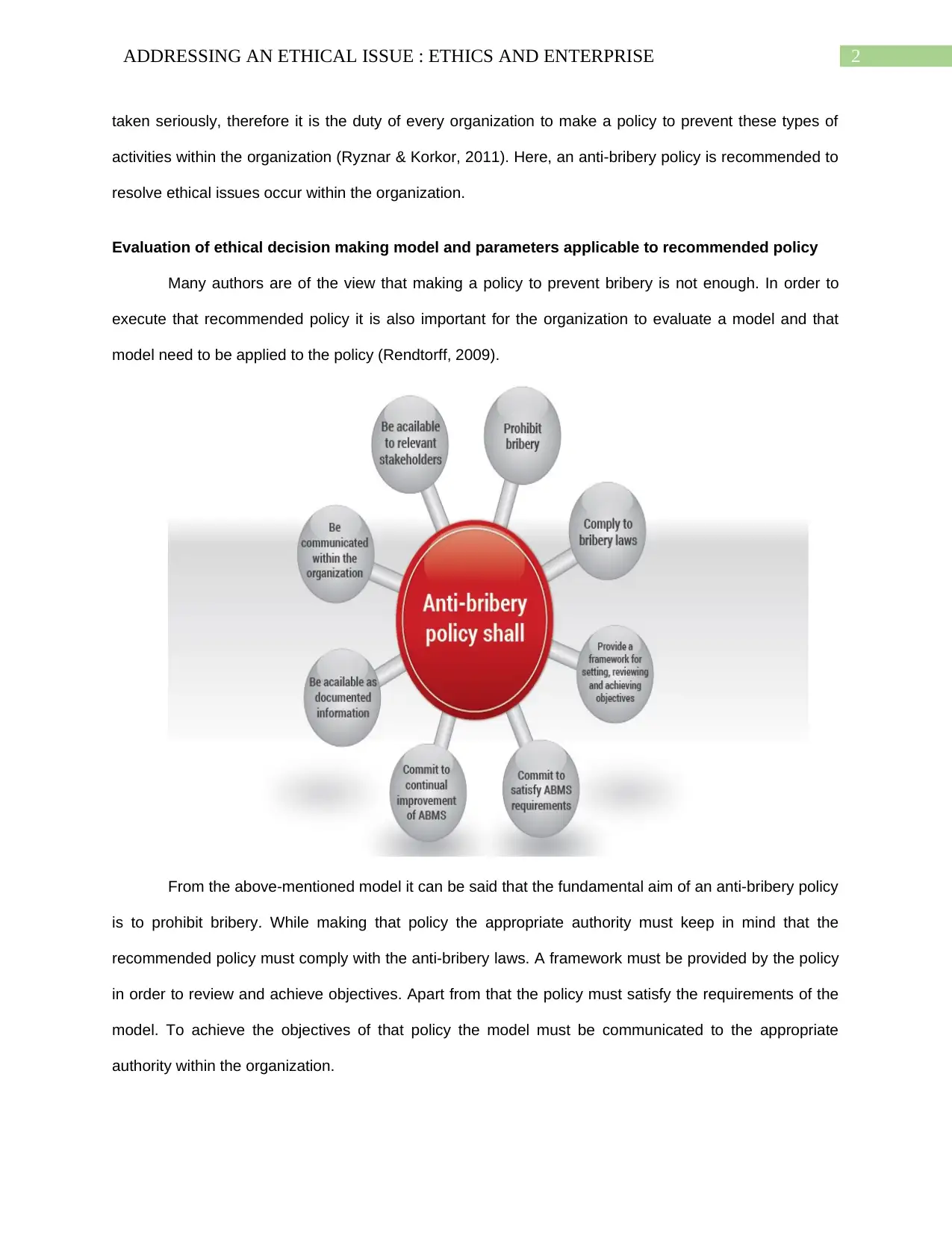
2ADDRESSING AN ETHICAL ISSUE : ETHICS AND ENTERPRISE
taken seriously, therefore it is the duty of every organization to make a policy to prevent these types of
activities within the organization (Ryznar & Korkor, 2011). Here, an anti-bribery policy is recommended to
resolve ethical issues occur within the organization.
Evaluation of ethical decision making model and parameters applicable to recommended policy
Many authors are of the view that making a policy to prevent bribery is not enough. In order to
execute that recommended policy it is also important for the organization to evaluate a model and that
model need to be applied to the policy (Rendtorff, 2009).
From the above-mentioned model it can be said that the fundamental aim of an anti-bribery policy
is to prohibit bribery. While making that policy the appropriate authority must keep in mind that the
recommended policy must comply with the anti-bribery laws. A framework must be provided by the policy
in order to review and achieve objectives. Apart from that the policy must satisfy the requirements of the
model. To achieve the objectives of that policy the model must be communicated to the appropriate
authority within the organization.
taken seriously, therefore it is the duty of every organization to make a policy to prevent these types of
activities within the organization (Ryznar & Korkor, 2011). Here, an anti-bribery policy is recommended to
resolve ethical issues occur within the organization.
Evaluation of ethical decision making model and parameters applicable to recommended policy
Many authors are of the view that making a policy to prevent bribery is not enough. In order to
execute that recommended policy it is also important for the organization to evaluate a model and that
model need to be applied to the policy (Rendtorff, 2009).
From the above-mentioned model it can be said that the fundamental aim of an anti-bribery policy
is to prohibit bribery. While making that policy the appropriate authority must keep in mind that the
recommended policy must comply with the anti-bribery laws. A framework must be provided by the policy
in order to review and achieve objectives. Apart from that the policy must satisfy the requirements of the
model. To achieve the objectives of that policy the model must be communicated to the appropriate
authority within the organization.
⊘ This is a preview!⊘
Do you want full access?
Subscribe today to unlock all pages.

Trusted by 1+ million students worldwide
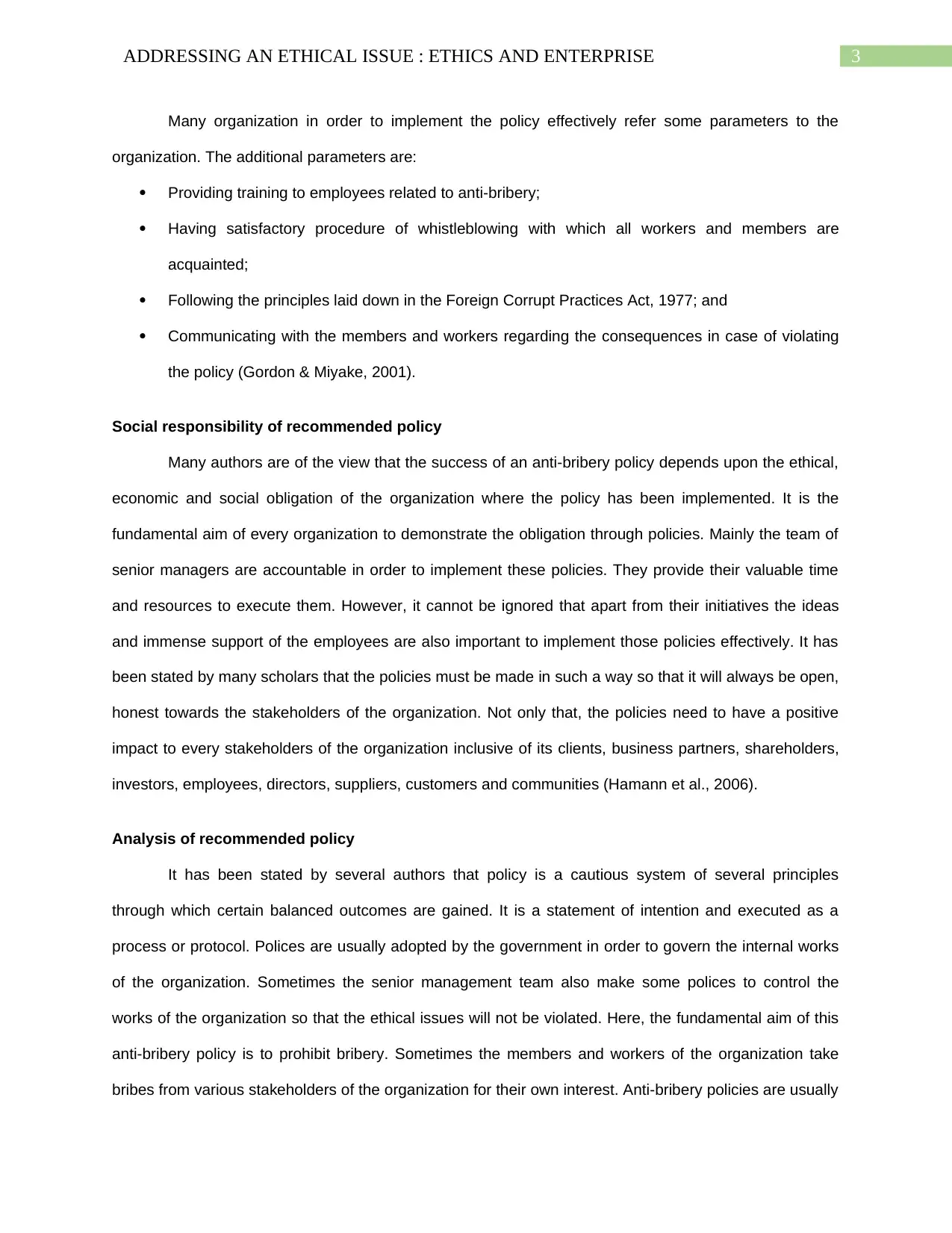
3ADDRESSING AN ETHICAL ISSUE : ETHICS AND ENTERPRISE
Many organization in order to implement the policy effectively refer some parameters to the
organization. The additional parameters are:
Providing training to employees related to anti-bribery;
Having satisfactory procedure of whistleblowing with which all workers and members are
acquainted;
Following the principles laid down in the Foreign Corrupt Practices Act, 1977; and
Communicating with the members and workers regarding the consequences in case of violating
the policy (Gordon & Miyake, 2001).
Social responsibility of recommended policy
Many authors are of the view that the success of an anti-bribery policy depends upon the ethical,
economic and social obligation of the organization where the policy has been implemented. It is the
fundamental aim of every organization to demonstrate the obligation through policies. Mainly the team of
senior managers are accountable in order to implement these policies. They provide their valuable time
and resources to execute them. However, it cannot be ignored that apart from their initiatives the ideas
and immense support of the employees are also important to implement those policies effectively. It has
been stated by many scholars that the policies must be made in such a way so that it will always be open,
honest towards the stakeholders of the organization. Not only that, the policies need to have a positive
impact to every stakeholders of the organization inclusive of its clients, business partners, shareholders,
investors, employees, directors, suppliers, customers and communities (Hamann et al., 2006).
Analysis of recommended policy
It has been stated by several authors that policy is a cautious system of several principles
through which certain balanced outcomes are gained. It is a statement of intention and executed as a
process or protocol. Polices are usually adopted by the government in order to govern the internal works
of the organization. Sometimes the senior management team also make some polices to control the
works of the organization so that the ethical issues will not be violated. Here, the fundamental aim of this
anti-bribery policy is to prohibit bribery. Sometimes the members and workers of the organization take
bribes from various stakeholders of the organization for their own interest. Anti-bribery policies are usually
Many organization in order to implement the policy effectively refer some parameters to the
organization. The additional parameters are:
Providing training to employees related to anti-bribery;
Having satisfactory procedure of whistleblowing with which all workers and members are
acquainted;
Following the principles laid down in the Foreign Corrupt Practices Act, 1977; and
Communicating with the members and workers regarding the consequences in case of violating
the policy (Gordon & Miyake, 2001).
Social responsibility of recommended policy
Many authors are of the view that the success of an anti-bribery policy depends upon the ethical,
economic and social obligation of the organization where the policy has been implemented. It is the
fundamental aim of every organization to demonstrate the obligation through policies. Mainly the team of
senior managers are accountable in order to implement these policies. They provide their valuable time
and resources to execute them. However, it cannot be ignored that apart from their initiatives the ideas
and immense support of the employees are also important to implement those policies effectively. It has
been stated by many scholars that the policies must be made in such a way so that it will always be open,
honest towards the stakeholders of the organization. Not only that, the policies need to have a positive
impact to every stakeholders of the organization inclusive of its clients, business partners, shareholders,
investors, employees, directors, suppliers, customers and communities (Hamann et al., 2006).
Analysis of recommended policy
It has been stated by several authors that policy is a cautious system of several principles
through which certain balanced outcomes are gained. It is a statement of intention and executed as a
process or protocol. Polices are usually adopted by the government in order to govern the internal works
of the organization. Sometimes the senior management team also make some polices to control the
works of the organization so that the ethical issues will not be violated. Here, the fundamental aim of this
anti-bribery policy is to prohibit bribery. Sometimes the members and workers of the organization take
bribes from various stakeholders of the organization for their own interest. Anti-bribery policies are usually
Paraphrase This Document
Need a fresh take? Get an instant paraphrase of this document with our AI Paraphraser
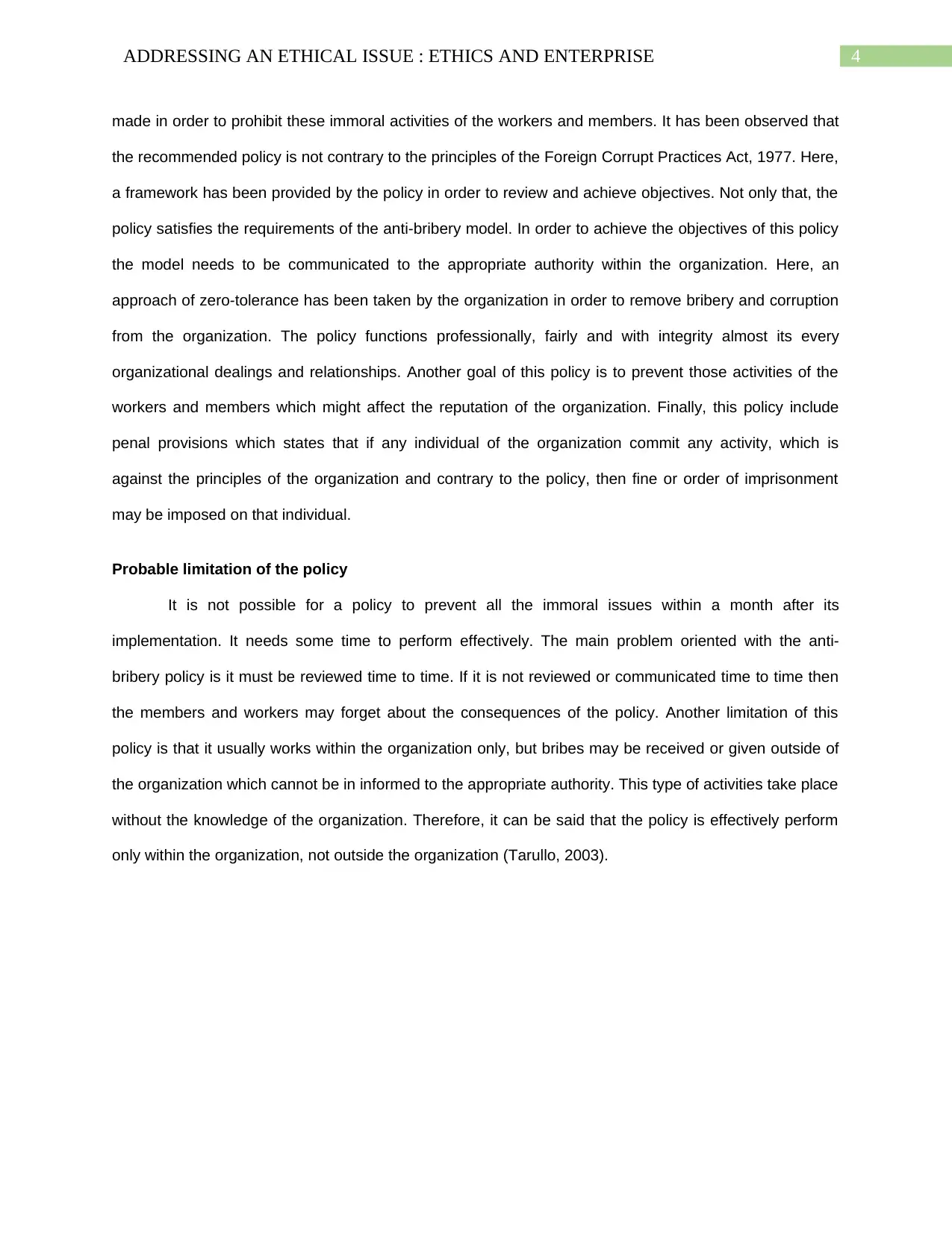
4ADDRESSING AN ETHICAL ISSUE : ETHICS AND ENTERPRISE
made in order to prohibit these immoral activities of the workers and members. It has been observed that
the recommended policy is not contrary to the principles of the Foreign Corrupt Practices Act, 1977. Here,
a framework has been provided by the policy in order to review and achieve objectives. Not only that, the
policy satisfies the requirements of the anti-bribery model. In order to achieve the objectives of this policy
the model needs to be communicated to the appropriate authority within the organization. Here, an
approach of zero-tolerance has been taken by the organization in order to remove bribery and corruption
from the organization. The policy functions professionally, fairly and with integrity almost its every
organizational dealings and relationships. Another goal of this policy is to prevent those activities of the
workers and members which might affect the reputation of the organization. Finally, this policy include
penal provisions which states that if any individual of the organization commit any activity, which is
against the principles of the organization and contrary to the policy, then fine or order of imprisonment
may be imposed on that individual.
Probable limitation of the policy
It is not possible for a policy to prevent all the immoral issues within a month after its
implementation. It needs some time to perform effectively. The main problem oriented with the anti-
bribery policy is it must be reviewed time to time. If it is not reviewed or communicated time to time then
the members and workers may forget about the consequences of the policy. Another limitation of this
policy is that it usually works within the organization only, but bribes may be received or given outside of
the organization which cannot be in informed to the appropriate authority. This type of activities take place
without the knowledge of the organization. Therefore, it can be said that the policy is effectively perform
only within the organization, not outside the organization (Tarullo, 2003).
made in order to prohibit these immoral activities of the workers and members. It has been observed that
the recommended policy is not contrary to the principles of the Foreign Corrupt Practices Act, 1977. Here,
a framework has been provided by the policy in order to review and achieve objectives. Not only that, the
policy satisfies the requirements of the anti-bribery model. In order to achieve the objectives of this policy
the model needs to be communicated to the appropriate authority within the organization. Here, an
approach of zero-tolerance has been taken by the organization in order to remove bribery and corruption
from the organization. The policy functions professionally, fairly and with integrity almost its every
organizational dealings and relationships. Another goal of this policy is to prevent those activities of the
workers and members which might affect the reputation of the organization. Finally, this policy include
penal provisions which states that if any individual of the organization commit any activity, which is
against the principles of the organization and contrary to the policy, then fine or order of imprisonment
may be imposed on that individual.
Probable limitation of the policy
It is not possible for a policy to prevent all the immoral issues within a month after its
implementation. It needs some time to perform effectively. The main problem oriented with the anti-
bribery policy is it must be reviewed time to time. If it is not reviewed or communicated time to time then
the members and workers may forget about the consequences of the policy. Another limitation of this
policy is that it usually works within the organization only, but bribes may be received or given outside of
the organization which cannot be in informed to the appropriate authority. This type of activities take place
without the knowledge of the organization. Therefore, it can be said that the policy is effectively perform
only within the organization, not outside the organization (Tarullo, 2003).
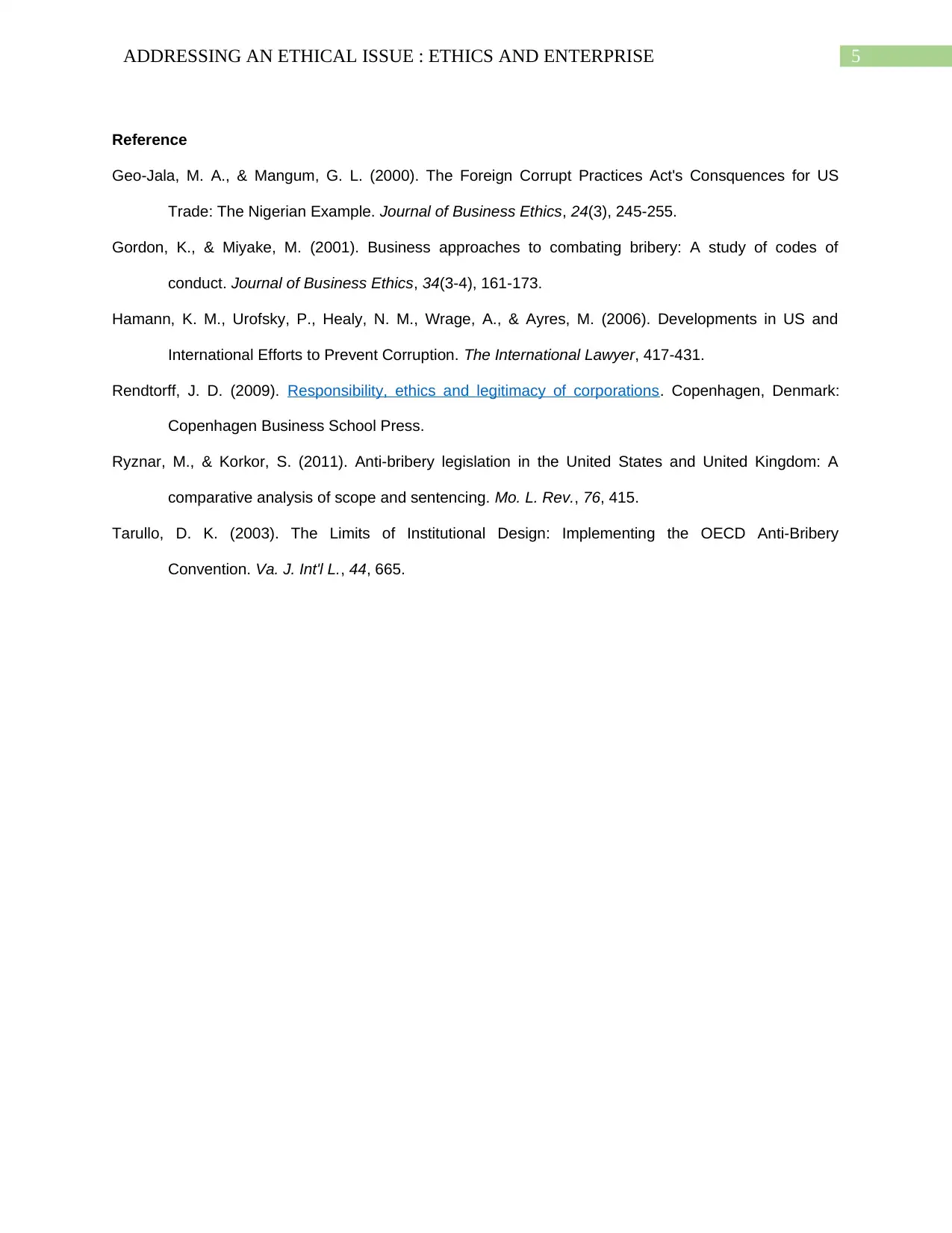
5ADDRESSING AN ETHICAL ISSUE : ETHICS AND ENTERPRISE
Reference
Geo-Jala, M. A., & Mangum, G. L. (2000). The Foreign Corrupt Practices Act's Consquences for US
Trade: The Nigerian Example. Journal of Business Ethics, 24(3), 245-255.
Gordon, K., & Miyake, M. (2001). Business approaches to combating bribery: A study of codes of
conduct. Journal of Business Ethics, 34(3-4), 161-173.
Hamann, K. M., Urofsky, P., Healy, N. M., Wrage, A., & Ayres, M. (2006). Developments in US and
International Efforts to Prevent Corruption. The International Lawyer, 417-431.
Rendtorff, J. D. (2009). Responsibility, ethics and legitimacy of corporations. Copenhagen, Denmark:
Copenhagen Business School Press.
Ryznar, M., & Korkor, S. (2011). Anti-bribery legislation in the United States and United Kingdom: A
comparative analysis of scope and sentencing. Mo. L. Rev., 76, 415.
Tarullo, D. K. (2003). The Limits of Institutional Design: Implementing the OECD Anti-Bribery
Convention. Va. J. Int'l L., 44, 665.
Reference
Geo-Jala, M. A., & Mangum, G. L. (2000). The Foreign Corrupt Practices Act's Consquences for US
Trade: The Nigerian Example. Journal of Business Ethics, 24(3), 245-255.
Gordon, K., & Miyake, M. (2001). Business approaches to combating bribery: A study of codes of
conduct. Journal of Business Ethics, 34(3-4), 161-173.
Hamann, K. M., Urofsky, P., Healy, N. M., Wrage, A., & Ayres, M. (2006). Developments in US and
International Efforts to Prevent Corruption. The International Lawyer, 417-431.
Rendtorff, J. D. (2009). Responsibility, ethics and legitimacy of corporations. Copenhagen, Denmark:
Copenhagen Business School Press.
Ryznar, M., & Korkor, S. (2011). Anti-bribery legislation in the United States and United Kingdom: A
comparative analysis of scope and sentencing. Mo. L. Rev., 76, 415.
Tarullo, D. K. (2003). The Limits of Institutional Design: Implementing the OECD Anti-Bribery
Convention. Va. J. Int'l L., 44, 665.
⊘ This is a preview!⊘
Do you want full access?
Subscribe today to unlock all pages.

Trusted by 1+ million students worldwide
1 out of 6
Related Documents
Your All-in-One AI-Powered Toolkit for Academic Success.
+13062052269
info@desklib.com
Available 24*7 on WhatsApp / Email
![[object Object]](/_next/static/media/star-bottom.7253800d.svg)
Unlock your academic potential
Copyright © 2020–2025 A2Z Services. All Rights Reserved. Developed and managed by ZUCOL.





